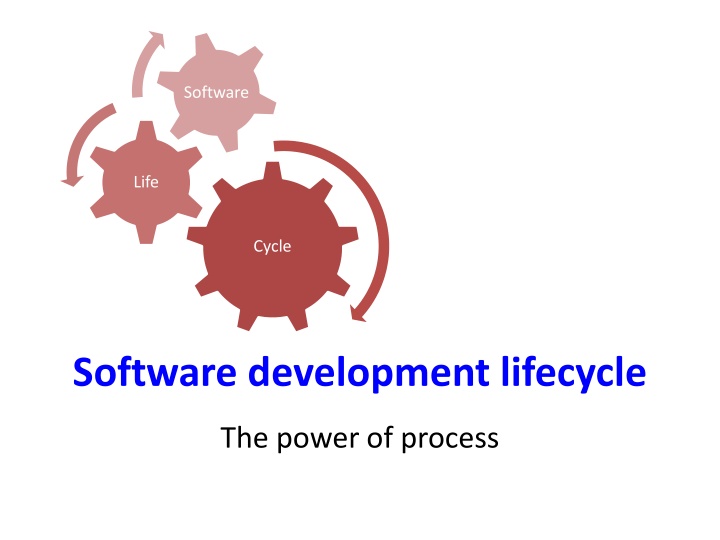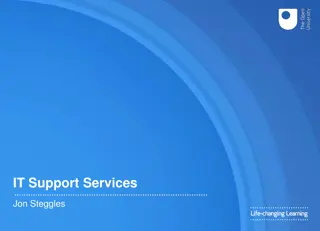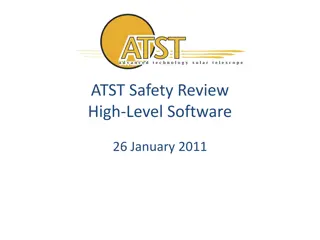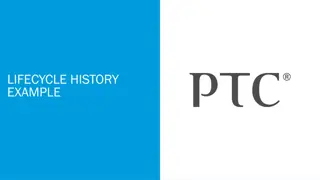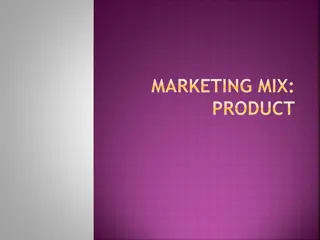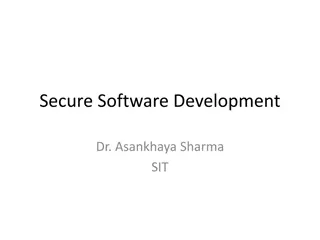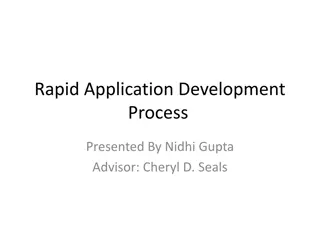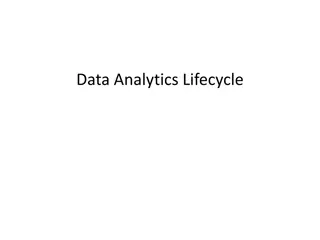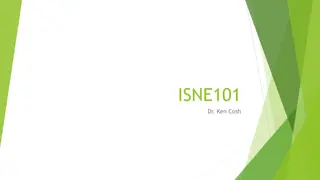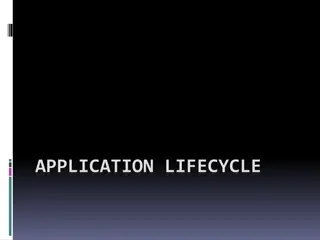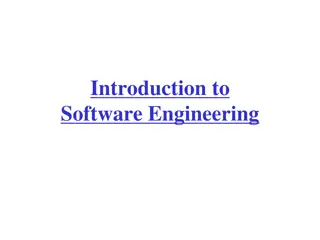Software Development Lifecycle Overview
Dive into the essential parts of software development, exploring the significance of lifecycle processes, various models, essential development tasks, roles, and phases involved. Understand the necessity of processes in avoiding costly bug fixes and ensuring successful software outcomes.
Download Presentation

Please find below an Image/Link to download the presentation.
The content on the website is provided AS IS for your information and personal use only. It may not be sold, licensed, or shared on other websites without obtaining consent from the author.If you encounter any issues during the download, it is possible that the publisher has removed the file from their server.
You are allowed to download the files provided on this website for personal or commercial use, subject to the condition that they are used lawfully. All files are the property of their respective owners.
The content on the website is provided AS IS for your information and personal use only. It may not be sold, licensed, or shared on other websites without obtaining consent from the author.
E N D
Presentation Transcript
Software Life Cycle Software development lifecycle The power of process
Outline The essential parts of development What is a software development lifecycle? Why do we need a lifecycle process? Lifecycle models and their tradeoffs Code-and-fix Waterfall Spiral Evolutionary prototyping Staged delivery
Essential Tasks of Development Requirements Design Implementation Testing Maintenance How are these related? What s a good order? 3
People Roles and Development Tasks What is/are the ? Requirements Design Implementation Testing plan Who produces the ? Requirements Design Implementation Testing Each phase requires different tools, knowledge, skill- set. There are lots of ways to split responsibilities. 4
The software lifecycle Software lifecycle: series of steps / phases, through which software is produced from conception to end-of-life can take months or years to complete Goals of each phase: mark out a clear set of steps to perform produce a tangible item allow for review of work specify actions to perform in the next phase
Why do we need process? Fixing bugs later is harder & more costly
Life without software process Ad-hoc development: creating software without process Advantages: there s nothing to learn or plan! work on whatever is interesting, ignore the rest. Disadvantages: may ignore some important tasks (testing, design) not clear when to start or stop doing each task scales poorly to multiple people hard to review or evaluate one's work code may not match user's needs (no requirements!) code was not planned for modification, not flexible
Project with little attention to process Survival Guide: McConnell p24
Project with early attention to process Survival Guide: McConnell p25
Some lifecycle models code-and-fix: write code, fix it when it breaks waterfall: perform each phase in order spiral: triage/figure out riskiest things first evolutionary prototyping: do the next easiest thing that could possibly lead to feedback staged delivery: build initial requirement specs for several releases, then design-and- code each in sequence
Are there analogies outside of SE? How did Hank design and build the Paul G. Allen Center for Computer Science and Engineering?
Lifecycles as management tool System for organizing effort among workers Forces planning and seeing consequences Splits work into smaller, tractable units Supports feedback and accurate timescales Processes support production at scale Drawbacks?
Limitations of lifecycle models Can lead to artificial design constraints Risk of overemphasizing process over results Models only approximate actual practices Ways of evaluating models risk management, quality/cost control, predictability, visibility of progress, customer involvement/feedback
Code-and-fix model Advantages Little or no overhead just dive in and develop, and see progress quickly Applicable sometimes for very small projects and short-lived prototypes But DANGEROUS for most projects No way to assess progress, quality or risks Unlikely to accommodate changes without a major design overhaul Unclear delivery features (scope), timing, and support
Waterfall model System Requirements Validation Software Requirements Validation Preliminary Design Validation Detailed Design Validation Code & Debug Development test Test Validation test Operations & Maintenance Revalidation
Waterfall model advantages Can work well for projects that are very well understood but complex Tackles all planning upfront The ideal of no midstream changes equates to an efficient software development process Supports inexperienced teams Orderly, easy-to-follow sequential model Reviews at each stage determine if the product is ready to advance
Waterfall model limitations Difficult to specify all reqs of a stage completely and correctly upfront requires a lot of planning up front (not always easy) assumes requirements will be clear and well-understood Rigid, linear; not adaptable to change in the product costly to "swim upstream" back to a previous phase No sense of progress until the very end nothing to show until almost done ("we're 90% done, I swear!") Integration occurs at the very end Defies integrate early and often rule Solutions are inflexible, no feedback until end Delivered product may not match customer needs Phase reviews are massive affairs Inertia means change is costly
Spiral model Spiral model risk oriented Determine objectives and constraints Identify and resolve risks Evaluate options to resolve risks Develop and verify deliverables Plan next spiral Commit (or not) to next spiral risk oriented
Spiral model Oriented towards phased reduction of risk Take on the big risks early, make decisions are we building the right product? do we have any customers for this product? is it possible to implement the product with the technology that exists today? tomorrow? Progresses carefully to a result tasks can be more clear each spiral
Spiral model Advantages Especially appropriate at the beginning of the project, when the requirements are still fluid Provides early indication of unforeseen problems Accommodates change As costs increase, risks decrease! Always addresses the biggest risk first
Spiral model disadvantages A lot of planning and management Frequent changes of task But, get to stick with one product feature/goal Requires customer and contract flexibility Developers must be able to assess risk Must address most important issues
Staged delivery model Waterfall-like beginnings Then, short release cycles: plan, design, execute, test, release with delivery possible at the end of any cycle
Staged delivery model advantages Can ship at the end of any release cycle Looks like success to customers, even if not original goal Intermediate deliveries show progress, satisfy customers, and lead to feedback Problems are visible early (e.g., integration) Facilitates shorter, more predictable release cycles Very practical, widely used and successful
Staged delivery model disadvantages Requires tight coordination with documentation, management, marketing Product must be decomposable Extra releases cause overhead
Evolutionary prototyping Develop a skeleton system and evolve it for delivery
Evolutionary prototyping Another popular and successful model, especially for custom products Staged delivery evolutionary prototyping Staged delivery: requirements are known ahead of time Evolutionary: discovered by feedback on each release Advantages Addresses risks early Steady signs of progress build customer confidence Useful when requirements are unknown or changing Participatory design / useful feedback loops
Evolutionary prototyping limitations Requires close customer involvement Assumes user's initial spec is flexible Problems with planning Especially if the developers are inexperienced Feature creep, major design decisions, use of time, etc. Hard to estimate completion schedule or feature set Unclear how many iterations will be needed to finish Integration problems fails for separate pieces that must then be integrated bridging; new software trying to gradually replace old Temporary fixes become permanent constraints Requires low friction deployment and experimentation
Embracing or fighting timelines Fit-to-schedule We will ship on a certain date and cut until it fits similar to the staged delivery model but less flexible because of the fixed shipping date requires careful prioritization of features and risks Fit-to-features/quality We ll ship the product when it is ready Trade predictable schedules for quality control
Why are there so many models? Choices are good! The choice of a model depends on the project circumstances and requirements A good choice of a model can result in a vastly more productive environment than a bad choice A cocktail of models is frequently used in practice to get the best of all worlds. Models are often combined or tailored to environment
Whats the best model? Consider The task at hand Risk management Quality / cost control Predictability Visibility of progress Customer involvement and feedback Aim for good, fast, and cheap. But you can't have all three at the same time.
Model category matrix Rate each model 1-5 in each of the categories shown: Risk Quality/ Risk mgmt. mgmt. 1 2 5 3 3 4 Quality/ cost ctrl. cost ctrl. 1 4 5 3 5 3 Predict- ability ability 1 3 3 2 3 5 Predict- Visibility of progress of progress 3 1 3 5 3 3 Visibility Customer Customer involvement involvement 2 2 3 5 4 2 code-and-fix code-and-fix waterfall Waterfall spiral spiral Iterative rototyping evolutionary prototyping staged delivery staged delivery design-to- design-to- schedule schedule 33
Whats the best model for.. A system to control anti-lock braking in a car A hospital accounting system that replaces an existing system An interactive system that allows airline passengers to quickly find replacement flight times (for missed or bumped reservations) from terminals installed at airports A mobile app for finding romantic partners
